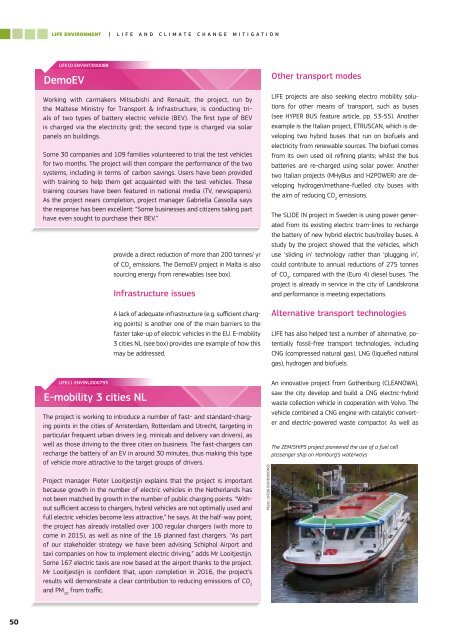Create successful ePaper yourself
Turn your PDF publications into a flip-book with our unique Google optimized e-Paper software.
LIFE ENVIRONMENT |LIFE and Climate CHANGE mitigationLIFE10 ENV/MT/000088DemoEVWorking with carmakers Mitsubishi and Renault, the project, run bythe Maltese Ministry for Transport & Infrastructure, is conducting trialsof two types of battery electric vehicle (BEV). The first type of BEVis charged via the electricity grid; the second type is charged via solarpanels on buildings.Some 30 companies and 109 families volunteered to trial the test vehiclesfor two months. The project will then compare the performance of the twosystems, including in terms of carbon savings. Users have been providedwith training to help them get acquainted with the test vehicles. Thesetraining courses have been featured in national media (TV, newspapers).As the project nears completion, project manager Gabriella Cassolla saysthe response has been excellent: “Some businesses and citizens taking parthave even sought to purchase their BEV.”provide a direct reduction of more than 200 tonnes/ yrof CO 2emissions. The DemoEV project in Malta is alsosourcing energy from renewables (see box).Infrastructure issuesA lack of adequate infrastructure (e.g. sufficient chargingpoints) is another one of the main barriers to thefaster take-up of electric vehicles in the EU. E-mobility3 cities NL (see box) provides one example of how thismay be addressed.Other transport modesLIFE projects are also seeking electro mobility solutionsfor other means of transport, such as buses(see HYPER BUS feature article, pp. 53-55). Anotherexample is the Italian project, ETRUSCAN, which is developingtwo hybrid buses that run on biofuels andelectricity from renewable sources. The biofuel comesfrom its own used oil refining plants; whilst the busbatteries are re-charged using solar power. Anothertwo Italian projects (MHyBus and H2POWER) are developinghydrogen/methane-fuelled city buses withthe aim of reducing CO 2emissions.The SLIDE IN project in Sweden is using power generatedfrom its existing electric tram-lines to rechargethe battery of new hybrid electric bus/trolley buses. Astudy by the project showed that the vehicles, whichuse ‘sliding in’ technology rather than ‘plugging in’,could contribute to annual reductions of 275 tonnesof CO 2, compared with the (Euro 4) diesel buses. Theproject is already in service in the city of Landskronaand performance is meeting expectations.Alternative transport technologiesLIFE has also helped test a number of alternative, potentiallyfossil-free transport technologies, includingCNG (compressed natural gas), LNG (liquefied naturalgas), hydrogen and biofuels.LIFE11 ENV/NL/000793E-mobility 3 cities NLThe project is working to introduce a number of fast- and standard-chargingpoints in the cities of Amsterdam, Rotterdam and Utrecht, targeting inparticular frequent urban drivers (e.g. minicab and delivery van drivers), aswell as those driving to the three cities on business. The fast-chargers canrecharge the battery of an EV in around 30 minutes, thus making this typeof vehicle more attractive to the target groups of drivers.Project manager Pieter Looitjestijn explains that the project is importantbecause growth in the number of electric vehicles in the Netherlands hasnot been matched by growth in the number of public charging points. “Withoutsufficient access to chargers, hybrid vehicles are not optimally used andfull electric vehicles become less attractive,” he says. At the half-way point,the project has already installed over 100 regular chargers (with more tocome in 2015), as well as nine of the 16 planned fast chargers. “As partof our stakeholder strategy we have been advising Schiphol Airport andtaxi companies on how to implement electric driving,” adds Mr Looitjestijn.Some 167 electric taxis are now based at the airport thanks to the project.Mr Looitjestijn is confident that, upon completion in 2016, the project’sresults will demonstrate a clear contribution to reducing emissions of CO 2and PM 10from traffic.Photo: LIFE06 ENV/D/000465An innovative project from Gothenburg (CLEANOWA),saw the city develop and build a CNG electric-hybridwaste collection vehicle in cooperation with Volvo. Thevehicle combined a CNG engine with catalytic converterand electric-powered waste compactor. As well asThe ZEM/SHIPS project pioneered the use of a fuel cellpassenger ship on Hamburg’s waterways50


